Frederic Remington
Chronicler of the Old West
by Bob Brooke
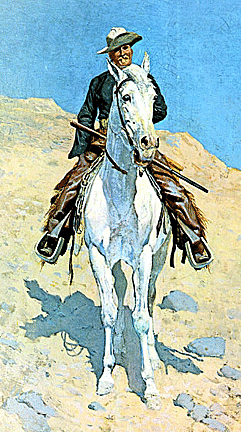 Harper’s
Weekly, the leading periodical of the late 19th century, once touted
Frederic Remington as the artist that “ draws what he knows and knows
what he draws.” Harper’s
Weekly, the leading periodical of the late 19th century, once touted
Frederic Remington as the artist that “ draws what he knows and knows
what he draws.”
That statement couldn’t have been further from the
truth since Remington had become the leading chronicler of the West–an
artist/historian whose works have kept the Old West alive for
generations since.
The Young Illustrator
Born in a big frame house on Court Street in Canton, New York, in 1861,
the only child of Seth Pierrepont Remington and Clara Bascomb Sackrider
Remington, Frederic Remington became more than a painter and sculptor.
Remington was an active boy who loved anything to do with the outdoors.
He disliked school and often had to be punished for playing hooky.
Instead of his lessons, he eagerly listened to his father tell stories
of the lands beyond the Mississippi. He even acted out his Western
fantasies by cutting the hair off a screaming friend’s head while
enacting a too realistic game of Indian scalping.
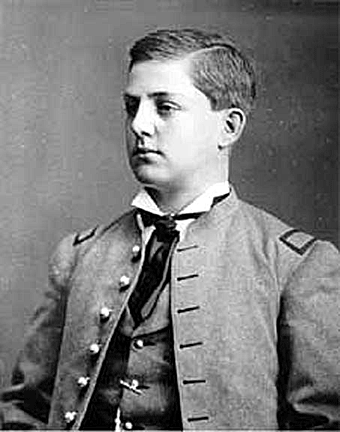 But,
above all, he loved horses and drawing. Throughout his early schooling,
Remington doodled images of horses, wild Indians, and soldiers in the
margins of his schoolbooks. His lack of interest in school forced his
father to send him to the Highland Military Academy in Worcester,
Massachusetts, in the fall of 1876. But,
above all, he loved horses and drawing. Throughout his early schooling,
Remington doodled images of horses, wild Indians, and soldiers in the
margins of his schoolbooks. His lack of interest in school forced his
father to send him to the Highland Military Academy in Worcester,
Massachusetts, in the fall of 1876.
Inspired by his studies of the military accounts of the Romans and the
Galls, he began painting pictures of his historical fantasies while on
summer vacation. He improvised a studio in his uncle's barn in Canton.
Even though he knew little about painting technique, he threw himself
into it with wholehearted enthusiasm and a determination to succeed.
Though his parents considered painting only for women, they indulged
their son and after graduating from Highland, he enrolled in Yale’s Art
School in Sept. 1878, but didn’t like drawing from plaster casts and
played football instead. He quit at Christmas vacation 1879 to take care
of his ailing father who eventually died of tuberculosis at 46, causing
young Remington to think a lot about death.
As he grew older, he became impatient and restlessness, both of his
ambitions and his artistic talent. The rugged life of the West seemed to
be the answer to the 19-year-old’s restlessness. He brought with him an
insatiable curiosity, an observant eye, and a deep interest in people
and places–and money he had inherited from his father.
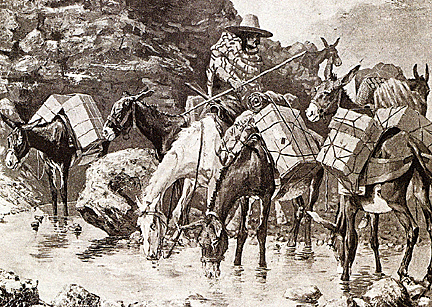 He
took a vacation trip to Montana in August 1881–from which he sold a
cowboy sketch to Harper’s Weekly that was so rough it had to be redrawn
by a staff artist. He
took a vacation trip to Montana in August 1881–from which he sold a
cowboy sketch to Harper’s Weekly that was so rough it had to be redrawn
by a staff artist.
Not only did he quickly adopt the life of the West, he began to record
it, both in drawings and in a journal. By 1884, Remington had seen far
more of the West than most men who lived there.
He had traveled the routes of the Oregon and Santa Fe Trails and had
ridden, camped, hunted, and come to know just about every region and
Native American tribe from the Bad Lands to the Rockies and from the
Canadian Border to the Rio Grande.
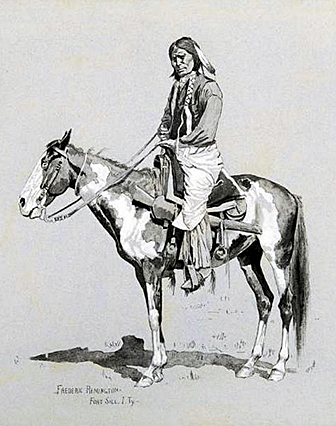 But
his dream of becoming an artist followed him as persistently as his
shadow. He devoted serious effort to sketching on a trip through the
Southwest in the spring of 1884. He traveled among the Cheyenne, the
Comanche, and the Apaches, so that he could draw them as he found them. But
his dream of becoming an artist followed him as persistently as his
shadow. He devoted serious effort to sketching on a trip through the
Southwest in the spring of 1884. He traveled among the Cheyenne, the
Comanche, and the Apaches, so that he could draw them as he found them.
He purchased beaded buckskin garments, ceremonial dance paraphernalia,
and silver-decorated horse trappings. Remington loved the West—the air,
the light, and the freedom he felt when there.
But all this traveling was getting him nowhere in particular, so he
headed back to Brooklyn, New York in 1885 with three dollars in his
pocket and a journal full of memories. He dressed as a cowboy.
His uncle, William Remington, lent him enough money to keep trying.
Eventually, Henry Mills Alden, Art Editor of Harper's Weekly, who bought
two of his rough sketches. Remington's first picture to be published
under his name—“The Apache War—Indian Scouts on Geronimo's
Trail”–appeared as a full-page cover illustration in Harper's Weekly in
the issue of January 9, 1886. Finally, he got his foot in the door and
soon his pictures began appearing with increasing regularity in the
magazine. He sold 25 drawings in the first 6 months of being an
illustrator.
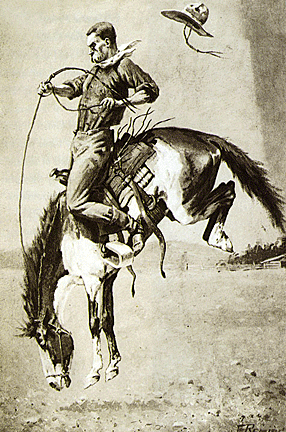 Remington
got another break when he discovered that Poultney Bigelow, a former
classmate at Yale, was the editor of Outing Magazine. His work first
appeared in Outing in December 1886 and during the following year there
were only two issues that didn’t contain his pictures. Remington
got another break when he discovered that Poultney Bigelow, a former
classmate at Yale, was the editor of Outing Magazine. His work first
appeared in Outing in December 1886 and during the following year there
were only two issues that didn’t contain his pictures.
Orders for illustrations began piling up. His first major assignment, a
commissioned to draw illustrations for articles written by Theodore
Roosevelt for Century Magazine, came in 1887. Roosevelt considered
Remington to be an authority on life in the West. Later, the articles,
along with 99 Remington illustrations, appeared in two books, Ranch Life
and The Hunting Trail. Both books became a success, establishing
Roosevelt as a writer and Remington as an artist of the West.
Unlike his fellow artists, he drew black
cavalrymen, Indians, and Mexicans without prejudice. Critics called his
Indians “caricatures.” In 1890, he produced 119 illustrations for
Harper's Weekly, including seven double-page spreads. That same year
Century Magazine used 18 of his illustrations.
His most important order during 1890 was to do 22 full-page plates and
nearly 400 text drawings for the Illustrated Edition of Henry Wadsworth
Longfellow's poem “The Song of Hiawatha.” This securely established
Remington's reputation when he was barely 30 years old.
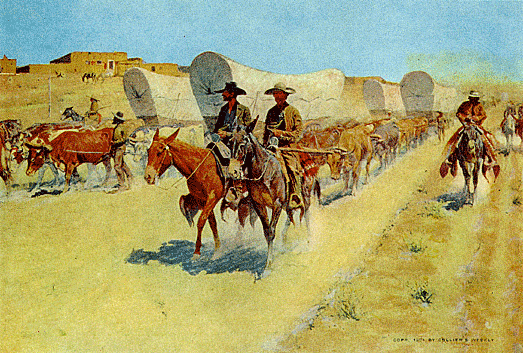
On January 7, 1892, only six years after the first Remington picture
appeared over his name in a magazine, Western historian Francis Parkman
asked him to draw the images for an illustrated edition of Parkman's
famous classic book The Oregon Trail, marking another important
milestone in his career.
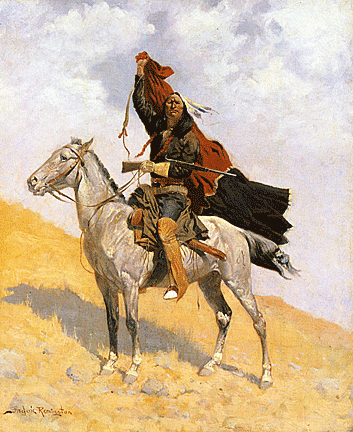 By
1895 Frederic Remington had become recognized as one of America's
foremost magazine and book illustrators. In New York City, he
gained celebrity status, mingling with the art and literary crowd at a
club called The Players. He was a man among men. Once he achieved this
status, he rewrote his autobiography to match, claiming to have helped
invent modern football, was a cowboy in Montana, and when he took his
western drawings to Harper’s Weekly, he was instantly an artist. By
1895 Frederic Remington had become recognized as one of America's
foremost magazine and book illustrators. In New York City, he
gained celebrity status, mingling with the art and literary crowd at a
club called The Players. He was a man among men. Once he achieved this
status, he rewrote his autobiography to match, claiming to have helped
invent modern football, was a cowboy in Montana, and when he took his
western drawings to Harper’s Weekly, he was instantly an artist.
He ate and drank obsessively and worked just as hard. His work grew more
sophisticated over time. Eventually, he stopped using a camera and drew
and painted from sketches and memory. And though cowboys were actually
from Mexico or of Mexican-American heritage, he painted them as Anglos
to please his public.
In 1898, Frederic Remington went to Cuba with the U.S. Fifth Army Corps
to report on the Spanish American War. But his weight and a fever made
him a casualty of the tropical heat. He weighed 295 pounds and drank
heavily.
The Maturing Process
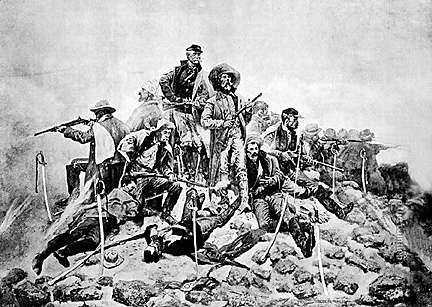 In
1899, Harper’s Weekly was in financial trouble and fired Remington. He
soon began working with Collier’s Magazine, which showed him its
appreciation by paying him more and promoting his work. By 1900, no
other American artist was as famous as Remington. In
1899, Harper’s Weekly was in financial trouble and fired Remington. He
soon began working with Collier’s Magazine, which showed him its
appreciation by paying him more and promoting his work. By 1900, no
other American artist was as famous as Remington.
Remington used photography extensively in
his work, taking hundreds of shots himself and often employing friends
to shoot some for him. Some of his works show its use, such as the
eye-level viewpoint and the stop-action pose of his subjects in many.
A change had come over his painting. He used looser brushstrokes and
more diffused light in his compositions, concentrating more on color
than on line. He began painting pure landscapes, with none of the story
qualities necessary for illustration. While magazines like Collier’s
required him to paint all his scenes in daylight, now he began to
produce evocative nocturnal scenes.
The Superstar
On his infrequent sketching trips out West, he became increasingly
disappointed in what he saw. “It’s all brick buildings, derby hats and
blue overhauls—it spoils my early illusions.”
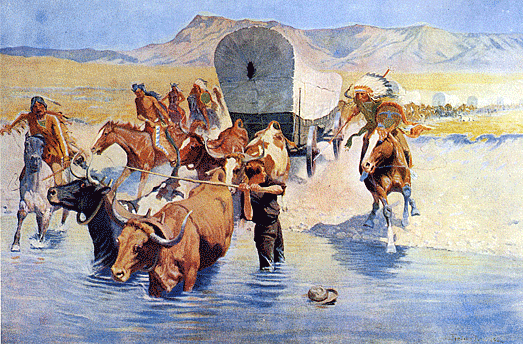
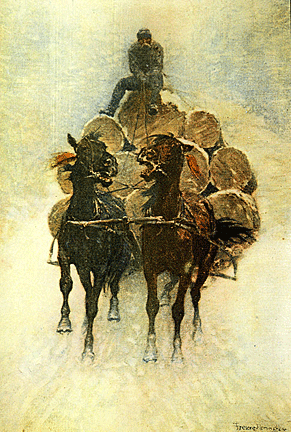 By
1903, Remington had decided to focus on fine art and not do any more
illustrations. He became preoccupied with capturing night effects on
canvas. He also learned to stop the action before its conclusion,
making his composition, “the Emigrants,” both pleasing and exciting. By
1903, Remington had decided to focus on fine art and not do any more
illustrations. He became preoccupied with capturing night effects on
canvas. He also learned to stop the action before its conclusion,
making his composition, “the Emigrants,” both pleasing and exciting.
By 1905, Remington was earning over $50,000 a year. During the latter
part of 1905 Remington created The Explorers series for Colliers, but
his fans wanted to dream of the exciting days of the old West.
He found the work he did for Collier’s Magazine the most distasteful of
his career, even though he had been paid handsomely for it. On Feb. 8,
1907, he “burned every old canvas in house today out on the snow”—about
75, including all except one of his Explorers series.
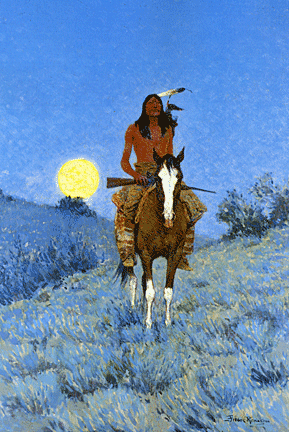 Remington
reminisced by saying, “My West passed out of existence so long ago to
make it merely a dream. It put on its hat, took up its blankets and
marched off the board, the curtain came down and a new act was in
progress.” Remington
reminisced by saying, “My West passed out of existence so long ago to
make it merely a dream. It put on its hat, took up its blankets and
marched off the board, the curtain came down and a new act was in
progress.”
The End of the Trail
He suffered from chronic appendicitis and on Dec. 18, 1909, just two
weeks after his last exhibition, he thought he had wrenched a stomach
muscle. Two days later, he had intense pains in his stomach. Three days
later doctors operated on him on his kitchen table. His appendix had
burst and peritonitis had set in. While he seemed to come through the
operation just fine, his condition changed on Christmas Day 1909. The
doctors told his wife, Eva, that his system had been so poisoned that he
wouldn’t recover. At 9:30 A.M. the following morning, Frederic Remington
drew his last breath. The chronicler of the Old West had come to the end
of the trail.
<
More Special Features
Next Article > |
